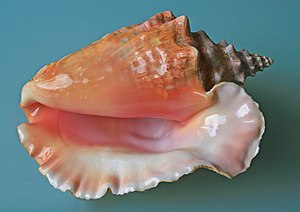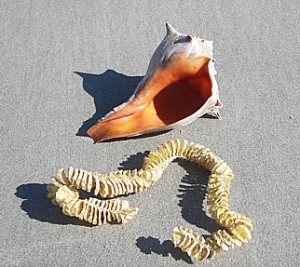It’s no surprise why my home state of New Jersey has been on my mind lately. Using my enthusiasm for nostalgia, I decided to investigate little known facts about the state. Today I am eager to share some at best ‘compelling’, but possibly ‘useless’ knowledge on the New Jersey’s state shell, the knobbed whelk.
- Governor Christine Todd Whitman declared the knobbed whelk (Busycon carica) the state shell on April 13, 1995.
- In addition to being the state shell of New Jersey, the knobbed whelk is also the state shell of Georgia.
- The shell of the knobbed whelk is coiled and pear-like and appears anywhere from yellow to gray in adults with purple and browns tints in juveniles. Its inside is typically pink to white and iridescent.
- The animal that lives inside the shell is a one-footed member of the sea-snail family (specifically the family, Melongenidae).
- Knobbed whelks are found off the east coast of the U.S. from Massachusetts to northern Florida.
- The meat of the whelk (and that of the conch) is known as scungilli.
- Whelks have a large pair of tentacles, each with a light-sensitive eyespot.
- Whelks also have a small pair of tentacles that are used for smell and touch.
- The U.S. exports whelks (i.e., knobbed, as well as lightning) to many areas of the world including France, Southeast Asia, Australia, and the Caribbean.
- Horseshoe crabs are used as bait to harvest channeled or knobbed whelks.
- There is a popular Korean side dish known as golbaengimuchim, which is seasoned whelks with spicy sweet and sour sauce with vegetables.
- Knobbed whelks can be up to 12 inches long.
- Knobbed whelks and lightning whelks can be distinguished by the difference in their openings. Knobbed whelks are dextral (i.e. right-handed).
- Knobbed whelks and lightning whelks lay strings of egg capsules.
- Knobbed whelks feast on clams using a radula.












What people are saying …